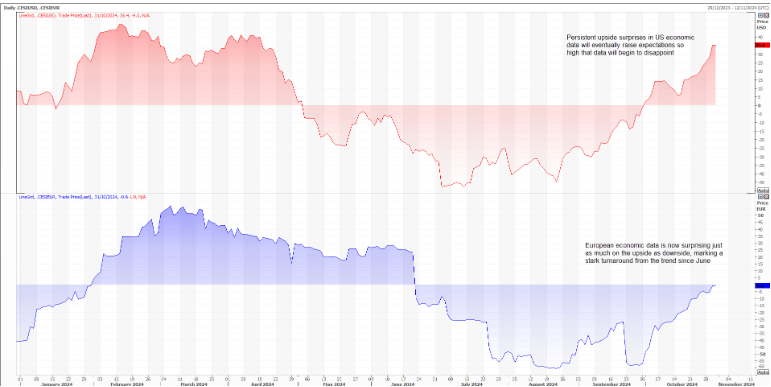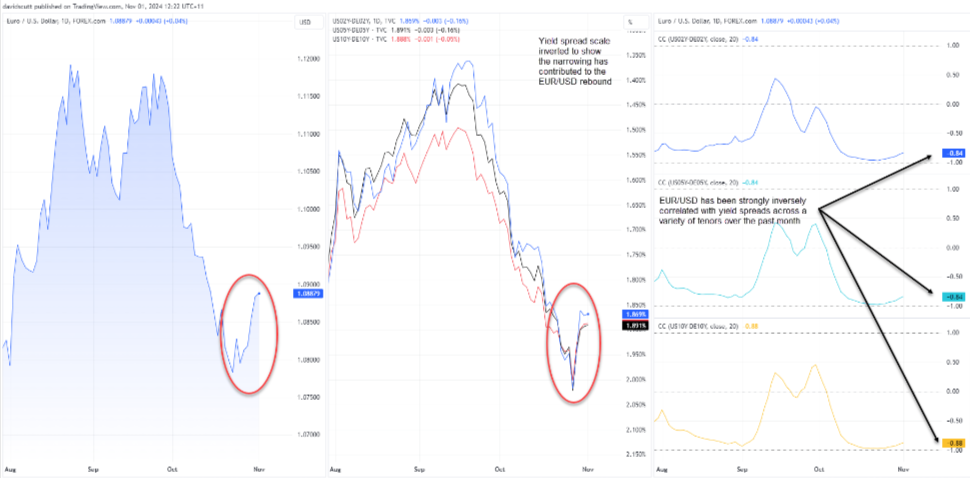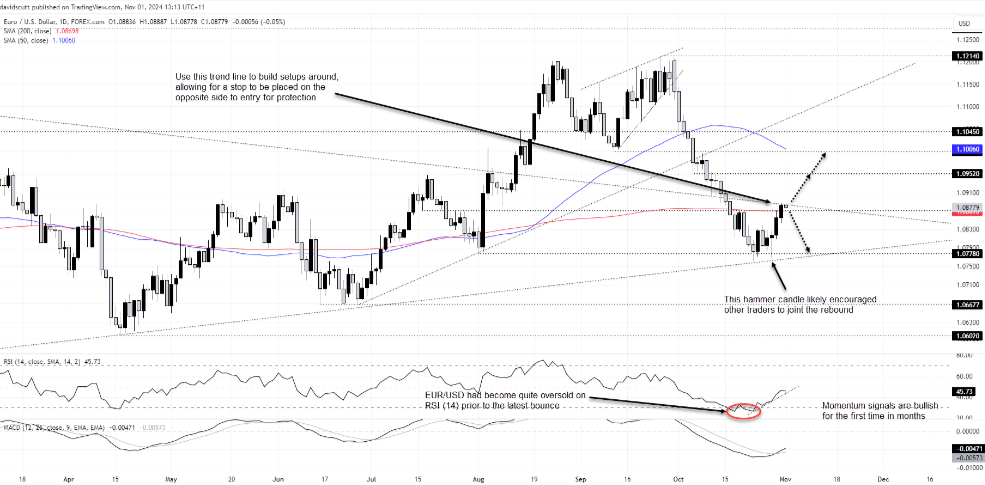- EUR/USD has bounced solidly this week
- Technicals, fundamentals and likely position squaring explain the rebound
- Price now testing long-running downtrend, providing level to build trade setups around
- Unemployment rate more important than payrolls for Fed policy outlook
Overview
A gradual improvement in euro area economic data has helped close the yawning yield gap with the United States, combining with oversold conditions on the daily timeframe to deliver a meaningful bounce in EUR/USD. Ahead of key risk events such as US non-farm payrolls, the US Presidential election, and Federal Reserve November rate decision, it now finds itself back at a key technical level, providing multiple trade setups depending on how the near-term price action evolves.
European data suddenly looks OK
While most traders know how impressive recent US economic data has been, many wouldn’t be aware that European data is no longer anywhere near as dire as what some of the headlines would have you believe.
Citi’s economic surprise index for euro area data is shown in blue in the chart below. For those who have not come across the indicator before, it tracks how data comes in relative to forecasts, with a score above 0 signaling that more data than not is topping expectation. The further away from 0, the greater the magnitude of net data surprises.

Even though the Euro area score remains marginally below 0, the proportion of data undershoots has diminished considerably over the past month, in part due to the bar being lowered after a lengthy period of disappointment. While the US index continues to power higher, at some point lofty expectations will start to deliver data disappointment, creating conditions where US dollar strength may fade.
We’re not there yet, but as a contrarian signal, this is one to put on the radar for swing and trend traders.
US-European yield spreads narrow, underpinning EUR/USD rebound
As euro area data flow has become less negative, it’s helped to deliver a reversal of the prior widening in interest rate differentials between the US and Europe, proxied in the chart below by German bund yields. That’s been a factor behind the bounce in EUR/USD, as demonstrated by the strong inverse correlation between two, five and 10-year yield spreads over the past month. As the gap has narrowed, EUR/USD has bounced.

EUR/USD rebound stalls at a familiar level
Another factor behind the rebound was short-term oversold conditions after a significant bearish reversal in EUR/USD that began in early October, seeing the price bounce after contemplating a test of long-running uptrend support.
Dips below 1.0778 were bought before a bullish hammer candle on Tuesday provided the signal traders would have been looking for to initiate long trades, fuelling the rebound over the next two sessions.
The price now finds itself testing downtrend support dating back to July 2023 after popping above the 200-day moving average, providing a decent level for traders to build setups around.
Source: TradingView
With RSI (14) in an uptrend and MACD confirming the bullish signal, near-term directional risks look skewed to the upside from a technical perspective. The bias, for the first time in quite a while, is to buy dips rather than sell rips.
However. I’d like to see how the price evolves after Friday’s US payrolls report before entering positions. If we see the downtrend break, you could buy with a stop below the 200-day moving average for protection. 1.0952 would be an initial target with the intersection of the 50-day moving average and horizontal resistance around 1.1000 the next after that.
Alternatively, if the price can’t break the downtrend, you could sell with a stop above the level for protection targeting a reversal to 1.0778 or uptrend support located around 10 pips lower.
From a fundamental perspective, the Fed is interested in unemployment, not payrolls growth. If we were to see a divergence between the two series later Friday, the preference would be to favour the signal from the unemployment rate.
